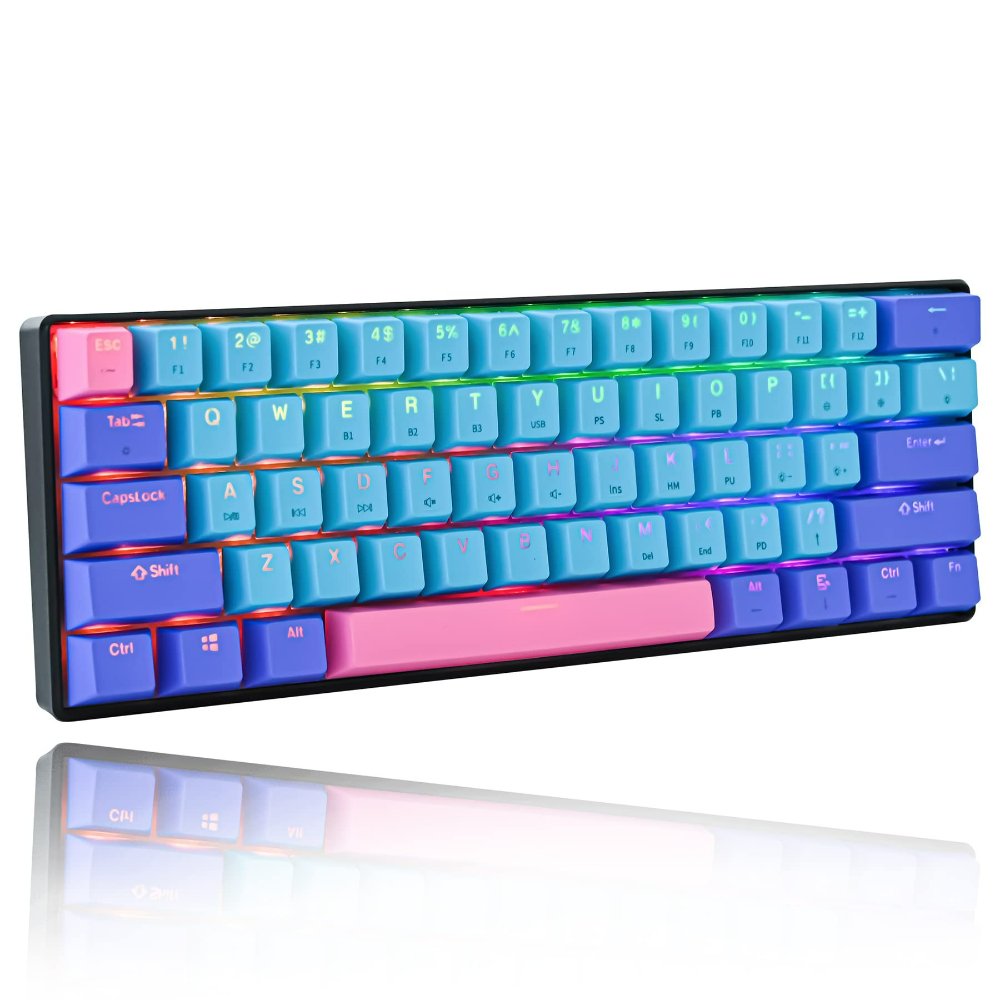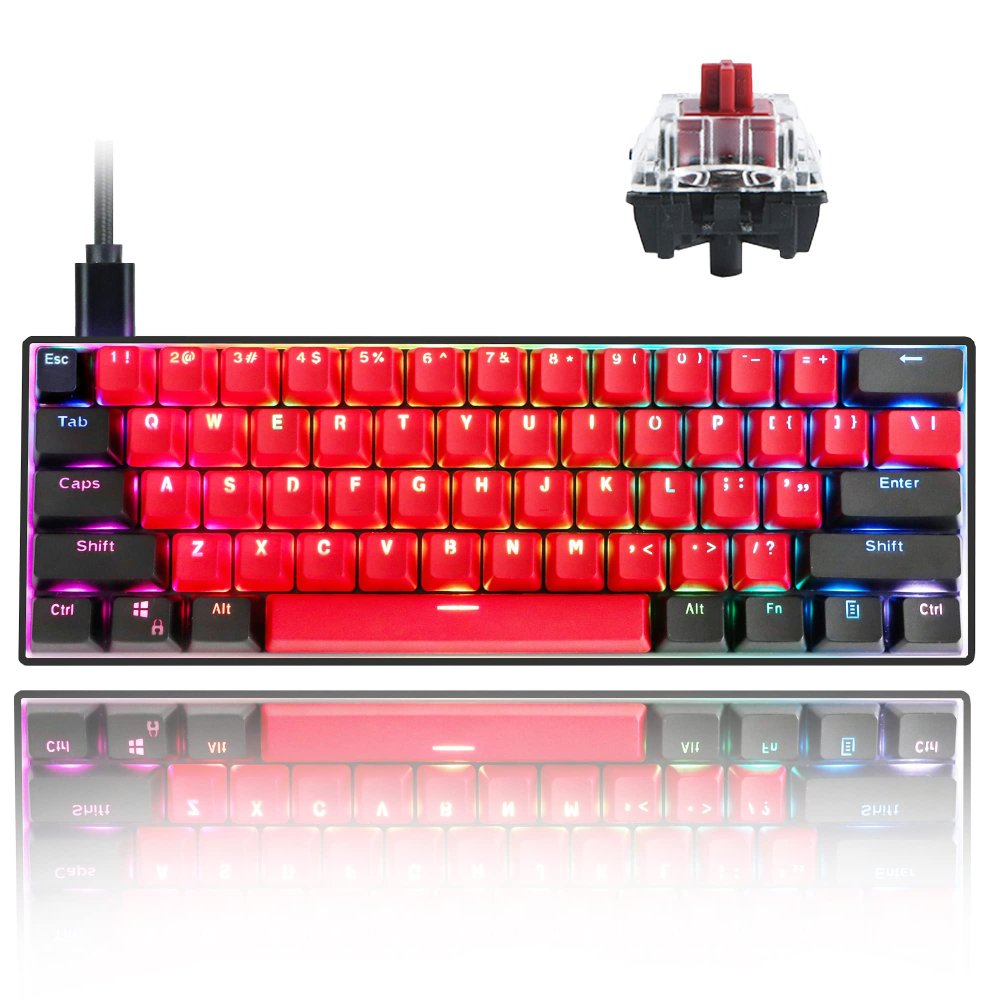Introduction to 60% Keyboards
A 60% keyboard is a compact option for desk setups. Unlike standard keyboards, it lacks a numeric pad, function row, and navigation cluster. The name ‘60%’ reflects its size, comparing to full-size keyboards. Users cherish it for its portability and the extra desk space it provides. Despite its smaller size, it doesn’t sacrifice essential keys. Instead, it employs a layered function system. This allows access to all standard keyboard functions in a condensed form. Its rising popularity stems from its minimalist design. It appeals to those who value efficiency in their workspace. In essence, the 60 keyboard trend is less about losing functionality. It’s more about gaining space and simplicity. For many, a 60 keyboard paves the way to a clutter-free and more ergonomic work environment. As we move through the blog, we’ll uncover how to harness the full potential of these innovative devices. We’ll delve into their advantages, customization options, and how they can enhance your typing or gaming experience.

Advantages of Using a 60% Keyboard
The 60% keyboard offers several benefits that appeal to minimalist and space-conscious users. Firstly, its small size frees up desk space, promoting a cleaner, more organized work area. This space efficiency can be crucial in smaller work environments or for those who prefer a streamlined setup.
Secondly, the reduction in keys leads to less finger movement and thus, potentially less strain. The compact layout encourages users to utilize shortcuts and function layers, enhancing typing speed and reducing the time needed for adjustments during use.
Furthermore, the 60 keyboard is highly portable. It is easy to transport between home and office or to cafes, making it ideal for remote workers or students. This versatility is not just a convenience but also expands the environments in which one can remain productive.
Lastly, aesthetically, the 60% keyboard is a standout. Its minimalist design complements modern decor and can make a tech workspace look more sophisticated and focused. The limited number of keys emphasizes a clean visual appeal that can be customized with various keycap styles and materials.
In conclusion, choosing a 60 keyboard can lead to a decluttered desk, less physical strain, increased portability, and an enhanced aesthetic appeal. Each of these advantages contributes to a more efficient and pleasant typing or gaming experience.
How to Choose the Right 60% Keyboard
Choosing the right 60 keyboard can dramatically enhance your experience. Here’s how to select the best one for your needs:
- Consider Compatibility: Your 60 keyboard should work seamlessly with your system. Check for compatibility with your operating system whether it’s Windows, macOS, or Linux.
- Assess Key Switches: Different key switches provide distinct typing experiences. From tactile to linear or clicky, ensure the switches match your preference for gaming or typing.
- Examine Build Quality: Durable materials mean a long-lasting keyboard. Look for sturdy frames, quality keycaps, and reliable switches.
- Evaluate Aesthetics: Since a 60 keyboard makes a visual statement, choose one that aligns with your style. Keycap designs and backlighting can reflect your personal aesthetic.
- Check for Programmability: Some 60 keyboards offer customizable keys. This can be a significant advantage for efficiency and comfort.
- Research Brand Reputation: Not all brands are equal. Read reviews and testimonials to gauge the reliability and customer service of the brand.
- Determine Budget: 60 keyboards come in a range of prices. Balance cost with features to find a keyboard that fits your financial limits without compromising on quality.
Your ideal 60 keyboard should align with your work or play style, enhance your space’s aesthetics, and stay within your budget without sacrificing quality or functionality. With these considerations, you’ll be well-equipped to make an informed decision.

Typical Layout and Key Functions
The typical layout of a 60% keyboard simplifies interaction while preserving essential functionality. Unlike full-size models, 60 keyboards omit the numeric pad, function row, and navigation cluster. This compact format contains approximately 61 keys, focusing mainly on the alphanumeric section, which includes letters, numbers, and basic punctuation.
Users access the absent functions through a layered key system. Most 60 keyboards use the ‘Fn’ (Function) key. Holding ‘Fn’ and pressing another key allows users to perform tasks normally dedicated to missing keys. For example, pairing the ‘Fn’ key with certain letter keys may adjust volume or screen brightness.
Key functions often vary between different models of 60 keyboards. It is important to check this aspect when choosing. Tailoring these functions through software or dips switches is common for personal preferences. This adaptability makes the 60 keyboard not only efficient in space but also in functionality.
Customizing Your 60% Keyboard
Customizing your 60 keyboard is a great way to enhance both aesthetics and functionality. Tailoring your keyboard to fit your preferences can improve your overall experience. Here’s a step-by-step guide to get you started:
- Choose Your Keycaps: Personalize the look with custom keycaps. You can choose from various colors, materials, and designs to suit your style.
- Define Your Layout: Use software to remap keys based on your usage patterns. This step allows you to place your most used actions where they feel most intuitive.
- Adjust the RGB Lighting: If your 60 keyboard has RGB, tweak the lighting settings. You can select colors and effects that match your mood or workspace vibe.
- Program Macros: For repetitive tasks, program macros. This can be especially useful for gaming or frequent editing commands in your workflow.
- Experiment with Different Angles: Adjust the tilt angle for better ergonomics. Some keyboards come with adjustable feet for this purpose.
- Upgrade Firmware: Keep your keyboard’s firmware up to date. Manufacturers often release updates that improve performance and add features.
Taking the time to customize your 60 keyboard not only optimizes its use but also makes it a more personal part of your workspace. Start with these simple steps, and you’ll soon have a keyboard that’s uniquely yours.

Key Shortcuts and Efficiency Tips
Optimizing your workflow with a 60% keyboard involves mastering key shortcuts. These shortcuts minimize hand movement and speed up task execution. Here are essential efficiency tips:
- Learn the Fn Layer: The ‘Fn’ key unlocks the full potential of a 60 keyboard. Memorize combinations for volume, brightness, and media control.
- Use Navigation Shortcuts: Instead of arrow keys, practice using ‘Fn’ with WASD or other assigned keys to navigate text.
- Embrace Layer Tapping: Tap ‘Fn’ once to change layers temporarily for quick commands, a feature in some 60 keyboards.
- Discover Software Shortcuts: Many programs have built-in shortcuts. Learn these to save time switching between tasks.
- Customize for Comfort: Assign shortcuts for frequently used functions. This reduces strain and increases speed.
- Stay Consistent: Use the same shortcuts daily. This builds muscle memory, making you faster over time.
- Keep Learning: Explore new shortcuts and update your habits as you discover more efficient methods.
With these tips, you’ll better adapt to the condensed layout, leading to quicker and more comfortable typing or gaming.
Transitioning from a Full-Size to a 60% Keyboard
Transitioning to a 60% keyboard from a full-size can seem daunting. You lose the dedicated number pad, function row, and arrow keys. However, it’s not just about adapting to fewer keys. It’s also about embracing a new approach to your workflow. Begin by familiarizing yourself with the basics of the 60 keyboard layout. You should identify the primary layer of keys and their functions. Next, learn the secondary functions accessed by the ‘Fn’ key. It’ll take time, but practice makes perfect.
Start slowly and introduce shortcuts into your daily routine. You may stumble at first, but consistency is key. Pay attention to your typing habits. Adjust your practice according to what feels natural. Keep a cheat sheet of shortcuts handy if you need a quick memory jog. Most importantly, don’t rush the switch. It’s advisable to alternate between your full-size and 60 keyboard initially.
As you get comfortable, the benefits begin to stand out. You’ll notice less desk clutter and more room to maneuver. Your fingers travel less distance, leading to potential improvements in typing speed and comfort. In no time, you’ll develop a rhythm with your 60 keyboard, enjoying the efficiency it brings to your desk space.
Best Practices for Typing and Gaming
Adopting best practices for typing and gaming with a 60% keyboard can transform your experience. These practices are designed to ensure efficiency, speed, and comfort. Here are key points to consider:
- Maintain Proper Posture: Good posture is crucial. Sit with your back straight and wrists in a neutral position to avoid strain.
- Familiarize with Key Placement: Spend time locating frequently-used keys. Familiarity reduces mistakes and increases typing speed.
- Practice Regularly: Consistent practice with your 60 keyboard will help build muscle memory and increase speed.
- Adjust Settings for Comfort: Tweak the keyboard’s tilt and settings for optimum comfort and performance.
- Use Shortcuts Efficiently: Mastering shortcuts on the 60 keyboard is a game-changer. Use them to minimize hand movement and speed up tasks.
- Enhance Key Responses: Some keyboards allow adjustment of key responsiveness. Utilize this feature to match your gaming or typing needs.
- Keep Keyboard Clean: A clean keyboard is more responsive and easier to use. Regular cleaning improves both functionality and aesthetics.
By implementing these practices, you enhance both your typing skills and gaming tactics, making the most of your 60 keyboard’s compact layout.